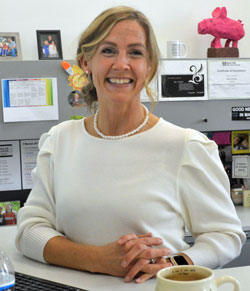Editor’s note: Traditional education has undergone profound change since the pandemic closed schools a year ago, forcing districts to offer virtual instruction as one way to help students learn safely. In a two-part story beginning today, SNN looks at how districts in Grand Rapids, Rockford and Wyoming have handled virtual schooling, and what they’ve learned for the future.
Multiple districts – In her 20 years as a teacher and assistant principal, one job Kelly Amshey could not have anticipated was presiding over empty classrooms.
But that is what the Rockford educator has done all school year as principal of Rockford Virtual, a new online school that was created to coordinate the instruction of over 900 students who chose all-virtual learning during the pandemic.
It’s a role the former assistant principal of the Rockford Freshman Center has taken on with energy and enthusiasm, but one that’s come laden with challenges.
“One of trickiest things about a virtual program, it can be somewhat challenging to support students when you do not see them,” Amshey told the Rockford Board of Education recently. “You can’t grab a kid and invite him in for lunch or have him meet you at the school early or stay after school to get that extra help.”
Still, she gave an upbeat assessment of a program that grew much more rapidly than expected, requiring 30 teachers, and which now enters its third trimester of students learning from home rather than from their school desks. Though by March 1 enrollment had fallen to 783, it’s still a substantial number of students choosing an actual virtual school for virtual schooling.
“We really feel like we’ve got a very good system in place and we are capturing our students, much the same as we would do in the school building,” she told the school board.
A year after schools statewide were forced to close their doors by a rampant virus, teachers and students alike have learned a ton about how to do online learning. Yet while studies have shown substantial learning loss during the pandemic, especially for students of color, local leaders expect some virtual learning will be with us for a while even as the vaccine reduces the toll of COVID-19 and more students return to classrooms.
‘It was difficult not to be distracted and not be bored when I was looking at the screen for six or seven hours.’
— Lemaria Benson-Stevens, City High Middle School senior
Rockford Superintendent Michael Shibler recently emailed parents that the district will continue to offer Rockford Virtual next school year, citing “very positive” feedback from parents. A virtual learning component is likely to continue as well in Grand Rapids Public Schools, which was all-virtual until January and where 42 percent of students are still in that mode.
“I think this has opened our eyes to a lot of things,” said GRPS Deputy Superintendent Ron Gorman. “It’s changed how we’ve done business.” Noting many parents likely won’t want to send their children back to school by next fall, he said, “It’s a model we’re all going to have to embrace probably for the next couple of years.”

Challenges for Teachers, Students and Parents
It’s a model many teachers, students and their parents have had to embrace this school year, like it or not. For Lysa Stockwell, a fourth-grade teacher for Wyoming Public Schools, it’s meant jumping from Zoom to Zoom to work with small groups while keeping track of each student’s progress. But she’s maintained a positive outlook on an unprecedented situation.
“We had to take everything we knew as teachers and reconstruct it for this virtual world,” said Stockwell, a 26-year veteran. “We have had to completely readjust our career. Everybody is a brand-new teacher.”
Related story: Teaching in the ‘virtual world’ and jumping from Zoom to Zoom
Things are nearly brand-new for classroom teachers as well, with social distancing, sanitizing and masks deployed to keep students and staff as safe as possible. Many are also teaching in-person and remote students simultaneously. Statewide, about two-thirds of districts are offering a choice of fully in-person or remote instruction, according to the Michigan Department of Education.
More students have returned to classrooms this semester, especially at the elementary level where transmission rates have been low. In Wyoming, more than 400 students moved from virtual to in-person and fewer than 40 went the other way, said Jennifer Slanger, director of teaching and learning.
“I can’t speak highly enough of our staff who are working so, so hard. They did not ask for this, but they have risen up to any expectation and have done a phenomenal job,” Slanger said.
With all Kent ISD districts providing a virtual option, and many like GRPS offering hybrid plans, it’s been imperative for schools to improve how well students learn online despite the technical glitches and lack of personal contact.
‘We have had to completely readjust our career. Everybody is a brand-new teacher.’
– Lysa Stockwell, Wyoming fourth-grade teacher
Virtually no one is saying virtual learning is better overall for students, although local districts say it’s too early to make precise data comparisons to in-person. Still, some students have found it preferable. One father told Amshey his son was doing better online because in the past he had behavior problems in class.
“I don’t think it’s most kids, but there are some kids who say, ‘Hey, I really like this virtual space,’” said Gorman of GRPS. “They do well because they can just kind of get in their own zone: ‘These are the assignments I need to complete.’”

No Substitute for Personal Attention
But for many students it’s been tough to work through spotty connectivity, distractions at home, lack of on-the-spot help from teachers and sheer boredom.
Further, the absence of warm, personal attention from teachers has been really hard on students’ mental and emotional well-being. Surveys have shown a rise in teens struggling with anxiety, depression and loneliness during the pandemic.
“The social-emotional component is a huge negative,” Gorman said. “There are kids who will not get across the stage unless they have a caring adult who is that motivator, who keeps students on track.”
That means telling students they need to do better if they want to pass, then saying, “You can do this,” Gorman added. “It’s difficult to have those relationships through a computer screen.”
‘I think this has opened our eyes to a lot of things. It’s changed how we’ve done business.’
— GRPS Deputy Superintendent Ron Gorman
It’s also more difficult, for elementary teachers in particular, to monitor students’ progress through a computer screen, said Rockford’s Kelly Amshey.
“In a classroom, the teacher can take a lap around the room and, in two minutes, he/she has an idea of each student’s skill,” Amshey wrote in an email. “He/she can even stop to give feedback in that very short time. It now takes loads of time for students to upload their work, and for the teacher to click each piece, look at it, respond to it, and then send it back.”
Obvious as it may seem, the pandemic has highlighted the vital importance of skilled, caring teachers working in classrooms to nurture students’ academic and social development, educators widely agree.
“I think what we’ve learned from this is nothing can compare to an in-person classroom teacher,” Gorman said. “This has really driven that point home, because education is so much more than content.”
Erin Albanese contributed to this report
CONNECT
For some kids, remote learning will continue this fall. Can schools make it better?









